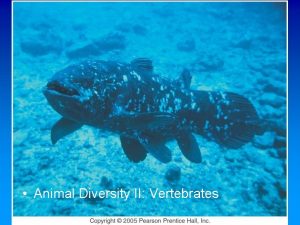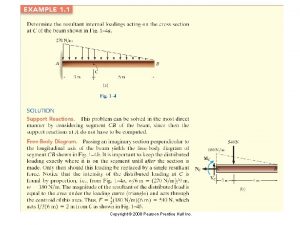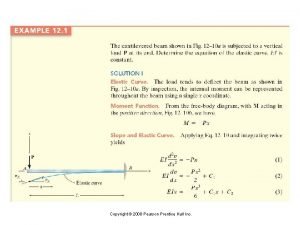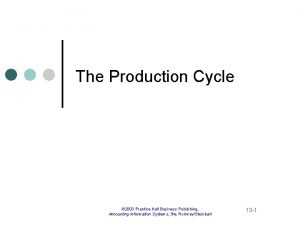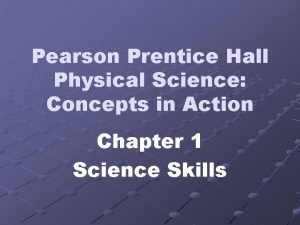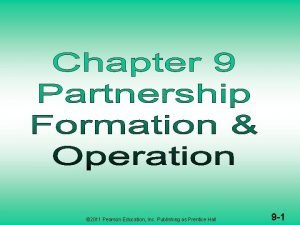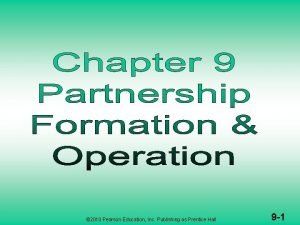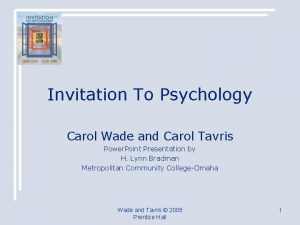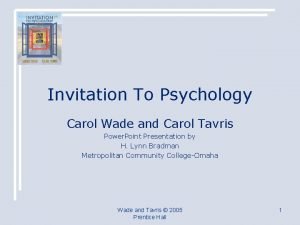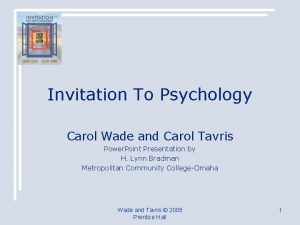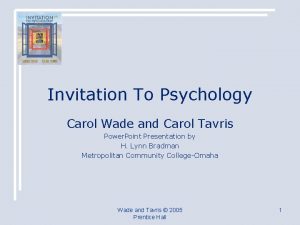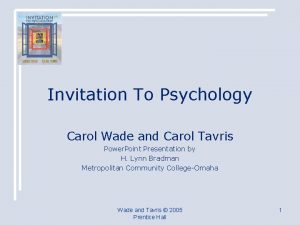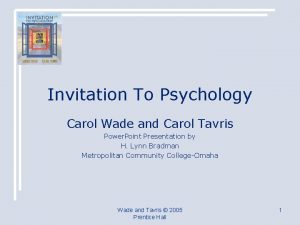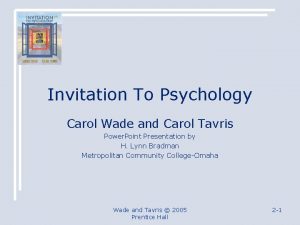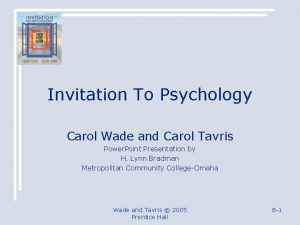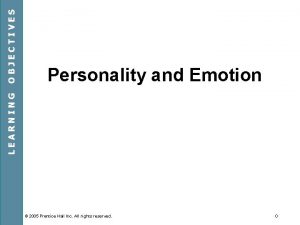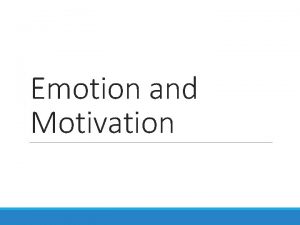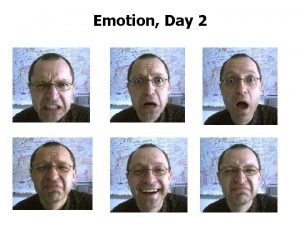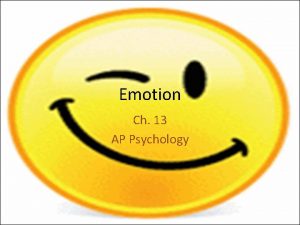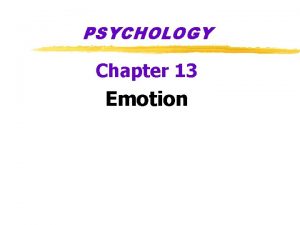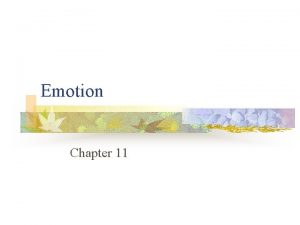Emotion Wade and Tavris 2005 Prentice Hall 2




























- Slides: 28

Emotion Wade and Tavris © 2005 Prentice Hall 2

The Varieties of Emotion • Primary Emotions: – Emotions that are considered to be universal and biologically based; they generally include fear, anger, sadness, joy, surprise, disgust, and contempt. • Secondary Emotions: – Emotions that are specific to certain cultures. Wade and Tavris © 2005 Prentice Hall 3

What is Emotion? • A state of arousal involving facial and bodily changes, brain activation, cognitive appraisals, subjective feelings, and tendencies toward action. • 3 Components: 1. Physiological changes (e. g. , fight or flight, increased heart rate) 2. Subjective feeling (e. g. , happiness) 3. Behavior (e. g. , smiling; running away) Wade and Tavris © 2005 Prentice Hall 4

The Chicken/Egg dilemma • Which happens first: do we feel the emotion first and then act, or do we react first then figure out the emotion? – What do you think? – Are you laughing because it’s funny, or do you think it’s funny because you laughed? – Have you ever felt unhappy or uneasy and not known why? Wade and Tavris © 2005 Prentice Hall 5

Chicken/Egg Dilemma • Most modern Psychologists now agree that these factors combine to form emotion • The Schachter Two-Factor theory of emotion, based on a study by Schachter & Singer (1962) • The theory that emotions depend on both physiological arousal and a cognitive interpretation of that arousal. Wade and Tavris © 2005 Prentice Hall 6

Biology and emotion • 1. 2. 3. 3 Biological areas of emotion: Facial Expressions Brain Regions and circuits Autonomic Nervous System (physiological changes) Wade and Tavris © 2005 Prentice Hall 7

1. Facial Expressions • The process by which the facial muscles send feedback to the brain about the basic emotion being expressed. • Studies show that smiling will make you feel better; grimacing will make you feel angrier • Emotions are also contagious among people via facial expression Wade and Tavris © 2005 Prentice Hall 8

1. Facial Expressions • Evolutionary basis: Darwin argued that human facial expressions are a built-in product of evolution; – they evolved because they signaled friendly or hostile intent. – What do you think is the evolutionary purpose of the emotion of disgust? Wade and Tavris © 2005 Prentice Hall 9

Darwin’s Taxonomy of Emotion Wade and Tavris © 2005 Prentice Hall 10

Emotion and the body • Evidence: Certain emotional displays seem to be universal. – Recognized throughout the world – Appear early in development – Babies not only display emotions, but also recognize them • What’s the first thing a baby will probably do when she falls? Wade and Tavris © 2005 Prentice Hall 11

Can you identify these emotions? Wade and Tavris © 2005 Prentice Hall 12

How about these? Wade and Tavris © 2005 Prentice Hall 13

2. Brain Regions and Circuits • There is a long route and a short route from the thalamus (sensory input) to the amygdala (emotional processing) • The short route goes directly from the thalamus to the amygdala to the autonomic nervous system • The long route passes through the cerebral cortex and hippocampus for more detailed processing Wade and Tavris © 2005 Prentice Hall 14

2. Brain Regions and Circuits • The amygdala is hypersensitive to danger and will immediately trigger your autonomic nervous system • If the cerebral cortex later realizes there is no real danger, you will begin to relax • Why are we set up this way? (Hint: think of an evolutionary explanation) Wade and Tavris © 2005 Prentice Hall 15

2. Brain Regions and Circuits • Amygdala seems responsible for evaluating sensory information for emotional importance. • Cerebral cortex incorporates other information and can override the amygdala Wade and Tavris © 2005 Prentice Hall 16

2. Brain Regions and Circuits • Signals can travel back and forth between the amygdala, the hippocampus, and the cerebral cortex, but the amygdala is able to exert a stronger influence – Our brains tend to err on the side of caution Wade and Tavris © 2005 Prentice Hall 17

Research • What impact would damage to the amygdala have on your reaction to scary situations? • The amygdala is important in emotion, and especially important in allowing us to feel and recognize fear, anger, and disgust. • Phillips & Le. Doux (1992); Bechara et. al. (1995) Wade and Tavris © 2005 Prentice Hall 18

Other brain research • People with damage to the amygdala are less able to recognize fear in others. – Mirror Neurons allow us to not only recognize, but actually feel and experience others’ emotions as well as the reasons why they act (Iacoboni 2005) Wade and Tavris © 2005 Prentice Hall 19

3. Autonomic Nervous System (Physiological Responses) • When the amygdala signals fear, the sympathetic division of your autonomic nervous system releases hormones to assist you: – Epinephrine and norepinephrine dialate your pupils, increase your heart rate and breathing rate, raise your blood sugar, slow digestion, etc. Wade and Tavris © 2005 Prentice Hall 20

3. Autonomic Nervous System (Physiological Responses) • Your body produces epinephrine and norepinephrine for most high affect emotions: – Excitement, anger, infatuation/love, worry, cheering at a sports event, playing a video game, etc. • Polygraph tests Wade and Tavris © 2005 Prentice Hall 21

Polygraph Tests • Tests autonomic responses: pulse, breathing rate, fidgeting, skin response • Not much specific psychological support • Inadmissible in most courts; illegal for most job screening • Some people do “beat” the test and lie, ie Aldrich Ames Wade and Tavris © 2005 Prentice Hall 22

Emotion and the Mind: Subjective Feeling • Appraisal: evaluation of an emotional state of being • One early theory is the Arnold theory: – Perception -> Appraisal -> Emotion • Lazarus has a newer, more complicated model which takes into account how the event may relate to us – Transactional: the environment produces emotions, and the individual finds ways to deal with them, respond to them, and may then change the environment. Wade and Tavris © 2005 Prentice Hall 23

Lazarus’ Model of Appraisal • Primary Appraisal 1. Motivational Relevance: Does it impact you and your goals? If no, then there is no emotion. If yes, continue… 2. Motivational Congruence: Does it promote your goals? Yes results in positive emotions, no in negative. 3. Accountability: You or someone else? (helps determine type of emotion) Wade and Tavris © 2005 24 Prentice Hall

Examples • Your classmate tells your teacher you cheated on a test • Your boyfriend/girlfriend takes you out to dinner • You accidentally break your mom’s favorite vase • A Japanese company kills whales and dolphins for profit Wade and Tavris © 2005 Prentice Hall 25

Lazarus’ Model of Appraisal • Secondary Appraisal: Reacting/Coping – Who is responsible? – How likely is the situation to change? – What options are available? – Can you accept/process the situation emotionally? • Secondary and Primary appraisal interact – For example, if you can easily change a situation, it won’t upset you as much. Wade and Tavris © 2005 Prentice Hall 26

Research • Speisman et. al. (1964) “Sub-incision” study • Aim: To see if cognitive appraisal impacts emotions • Procedure: All participants watch a film showing a right of passage for young adolescent boys in a primitive society in which the underside of the penis is cut deeply from the tip to the scrotum using a sharp stone Wade and Tavris © 2005 Prentice Hall 27

Speisman Procedure (cont’d) • IV: Subjects were divided into 4 groups, their videos were identical but had different soundtracks – Control: no soundtrack – Trauma condition: soundtrack played up the pain, danger and horror – Denial condition: narration said the boys were not hurt but were willing and joyful participants who "look forward to the happy conclusion of the ceremony. " – Scientific condition: narration encouraged viewer to consider the anthropological and scientific impact Wade and Tavris © 2005 Prentice Hall 28

Speisman et. al. (1964) • Procedure cont’d: Physiological (heart rate) and self-report (questionnaire) measures of emotion were taken • Findings: The trauma condition had a higher level of emotional reaction than the control; the denial and scientific conditions had less emotional reaction than the control • Conclusions & Criticisms? Wade and Tavris © 2005 Prentice Hall 29
 Copyright 2005 pearson prentice hall inc
Copyright 2005 pearson prentice hall inc 2005 pearson prentice hall inc
2005 pearson prentice hall inc 2008 pearson prentice hall inc
2008 pearson prentice hall inc Prentice hall inc
Prentice hall inc 2008 pearson prentice hall inc
2008 pearson prentice hall inc Pearson prentice hall
Pearson prentice hall Prentice hall inc
Prentice hall inc Prentice hall careers
Prentice hall careers Prentice hall america pathways to the present
Prentice hall america pathways to the present 2011 pearson education inc
2011 pearson education inc Prentice hall business publishing
Prentice hall business publishing Prentice hall african american history
Prentice hall african american history Pearson physical science concepts in action answers
Pearson physical science concepts in action answers Pearson education 2011
Pearson education 2011 Ocean fisheries
Ocean fisheries Pearson prentice hall
Pearson prentice hall Pearson education inc publishing as pearson prentice hall
Pearson education inc publishing as pearson prentice hall Phylum arthropoda common name
Phylum arthropoda common name Prentice hall business publishing
Prentice hall business publishing Pearson education inc. publishing as prentice hall
Pearson education inc. publishing as prentice hall Pearson education inc. publishing as prentice hall
Pearson education inc. publishing as prentice hall Pearson 2012
Pearson 2012 Prentice hall jobs
Prentice hall jobs Pearson education inc. publishing as prentice hall
Pearson education inc. publishing as prentice hall Pearson education inc. publishing as prentice hall
Pearson education inc. publishing as prentice hall Pearson education 2010
Pearson education 2010 Pearson education inc. publishing as prentice hall
Pearson education inc. publishing as prentice hall Elizabeth wade nhs
Elizabeth wade nhs Kris kappel
Kris kappel

